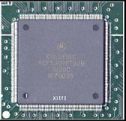
The Amiga Coldfire V4 CPU
Upgrade
A second attempt at developing a Coldfire processor upgrade to
the Classic Amiga. There are also plans to develop a standalone
AROS version. Unlike IAT Manufacturing's earlier effort, the upgrade
is being developed using the later Coldfire v4 CPU. The attraction
of the Coldfire CPU is evident. Unlike the expensive PowerPC
processors of next generation Amigas, the Coldfire V4 162Mhz costs
just £25. This would offer a significant performance increase
in comparison to existing 68060 software, while opening the
possibility for SDRam, Firewire, USB, Ethernet, & PCI expansion
for Amigas that are not covered by existing expansion options.
 Although the project faces an
uphill battle (depending upon the amount of work required to patch
the AmigaOS and produce prototype boards), the two-person team have
already had an offer of support by an undisclosed company that may
speed its development. In a project FAQ,
Oliver indicates the A2000 will be the
first Amiga to gain Coldfire support, followed (in order) by the
A4000, A500,
CD32, A600,
CDTV, A1000, and
possibly an A3000 version. An unusual list
that is heavily influenced by the machines available for testing
purposes and their individual architecture. Although the project faces an
uphill battle (depending upon the amount of work required to patch
the AmigaOS and produce prototype boards), the two-person team have
already had an offer of support by an undisclosed company that may
speed its development. In a project FAQ,
Oliver indicates the A2000 will be the
first Amiga to gain Coldfire support, followed (in order) by the
A4000, A500,
CD32, A600,
CDTV, A1000, and
possibly an A3000 version. An unusual list
that is heavily influenced by the machines available for testing
purposes and their individual architecture.
The Amiga Coldfire FAQ indicates that several stages will
require completion before the hardware is ready for consumer
use:
Stage 1 - "the first prototype will just have
the Coldfire in it, No SDRam memory or expansion ports, Just the
Coldfire. This will run much slower than the Coldfire is capable of
as it will have to use the motherboards ram but it will give us a
good idea of just how compatible the Coldfire is without the
Motorola patch, A provision will probably be made on this prototype
for a ROM so the patch can be loaded before the Kickstart."
Stage 2 - " If the Amiga fails (Due to
Kickstart exceptions) then we will either have to compile the AROS
source for the Coldfire or to start with just try different
Kickstart revisions, We need to get the basics up and running on
the Amiga before we can evolve the design, Workbench is
unimportant, CLI is all we need, Even the library's on the
workbench disk can be recompiled to the Coldfire as and when we
need it."
Stage 3 - "After we have a platform to build
off the next two things to add will be the SDRam / 72 Pin SIMM
slots, This will give an instant speed increase and let us fit half
a gig of ram onto the computer (Try doing that with a Cyberstorm
PPC) and adding an expansion/diagnostic port. We intend to have a
generic expansion port on each model of card so an upgrade for the
A500 will fit an A4000T and work just as fast, This also helps us
with diagnostics as it will have all the signals available, Giving
us a window into what's going on."
Subsequent development - "The expansion port
will latter carry upgrades such as Firewire, USB and ethernet ports
and PCI (Maybe Zorro 3 on Amiga`s with no Zorro 3 slots) slots.
(Some of these features may be built into cards where there is
plenty of room like on the A2000 and A500, Even the A3000."
Is the Coldfire project a realistic
development?
It is only natural that the majority of Amiga users will be
cynical at *yet another* hardware upgrade for the Amiga. The last
few years have produced dozens of abandoned efforts to produce a
suitable upgrade. The current emphasis upon AmigaOS 4 and PPC leave
little room for a Coldfire port. However, the Coldfire processor is
a natural upgrade to the 68k - an argument that has convinced many
Atari users. However, the
AmigaOS offers its own unique problems. Like existing PowerPC
boards, Amiga 68k will not benefit from a speed increase unless it
accesses the new hardware (coldfire.library?) or emulates the Amiga
processor. If the latter is the case, it will require access to the
Amiga chipset in order to execute hardware-hitting software. The
use of AROS removes this dependency, but may require a port of UAE
for users to consider it a 'real' Amiga. Whatever the result, its
development will be an education for its creators and the Amiga
market.
BACK
Last Update: 13/6/2002
|













